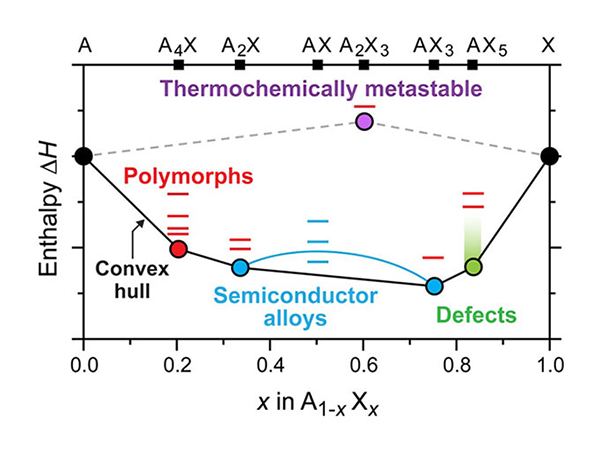About the Center for Next Generation of Materials Design
The Center for Next Generation of Materials Design (CNGMD) was an Energy Frontier Research Center funded by the U.S. Department of Energy Office of Science from 2014-2020. CNGMD’s objective was to dramatically transform the discovery of functional energy materials through multiple-property search, incorporation of metastable materials into predictive design, and the development of theory to guide materials synthesis.
While the CNGMD has concluded its work, this website remains as a record of the research conducted.
The CNGMD couples first-principles theory with state-of-the-art synthesis and characterization to understand and predict structure, properties, and phenomena at the molecular, nano, and meso scales. Further, the center is specifically designed to overcome four critical scientific "gaps"—multiple-property design, accuracy and relevance, metastability, and synthesizability—to make computational materials design a robust tool delivering new functional materials. Our initial materials focus has been semiconductors for solar energy conversion, solid-state lighting, and related technologies.

CNGMD researchers are studying four types of metastability above the convex hull of ground-state structures.
The Center for Next Generation of Materials Design consists of scientists from seven institutions: the National Renewable Energy Laboratory (NREL), the Colorado School of Mines, Harvard University, Lawrence Berkeley National Laboratory, Massachusetts Institute of Technology, Oregon State University, and SLAC National Accelerator Laboratory. Dr. William Tumas (NREL) is the Center Director.
The CNGMD's five goals are as follows:
Goal 1: Design and discover new energy-relevant materials with targeted functionalities by integrating theory, high-throughput computation, synthesis, and characterization. (See the Pnictide Search, Perovskite-Inspired Search, Chalcogenide Alloys, Polar Materials projects.)
Goal 2: Develop foundational tools for theory, synthesis, and characterization to enable the next generation of materials design. (See the Foundational Tools project.)
Goal 3: Incorporate metastable materials into materials design and establish an understanding of metastability including composition, and structure and formation energies for polymorphs, semiconductor alloys and defects. (See the Polymorphs & Synthesizability, Chalcogenide Alloys, Ternary Pnictides, Polar Materials, and Defect Phase Diagrams projects.)
Goal 4: Develop theory-driven approach to guide synthesis of new materials, including metastable systems, by coupling theory and state-of-the-art in-situ characterization to probe materials growth pathways. (See the Polymorphs & Synthesizability project.)
Goal 5: Promote and disseminate the Next Generation of Materials Design to the broader materials science community. (See the Outreach and Communications project.)